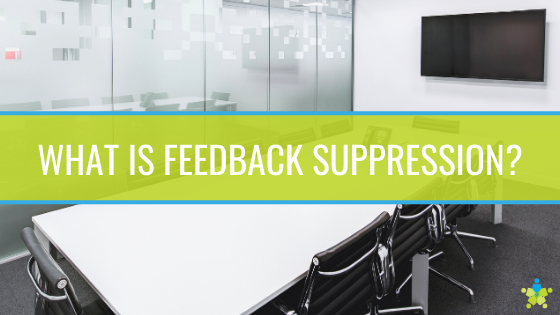[vc_row][vc_column][vc_column_text]While schools and businesses have changed the way they communicate remotely with students and employees, one of the biggest challenges on many platforms can be audio feedback. The task then becomes identifying and finding an audio solution that enables feedback suppression.[/vc_column_text][vc_column_text]
What Is Feedback Suppression?
Feedback suppression is the act of eliminating audio feedback. AV integrators are experts at dealing with the issue and can improve feedback suppression in a variety of ways. They will consider such things as the acoustics of the room and the placement of speakers when determining the best solution. Amidst the coronavirus pandemic, many schools and businesses are increasingly turning to specially designed audio solutions for feedback suppression. This allows meetings, class and collaboration to continue without the interference of audio feedback.[/vc_column_text][vc_column_text]All About Audio Feedback
Whether it is in an in person, virtual, or hybrid meeting or class, it is becoming increasingly common to at some point hear a high pitch ear splitting sound, more commonly known as audio feedback. Some situations that may cause audio feedback can include having:- Phone and computer audio live at the same time
- Multiple computers with audio enabled operating at the same time in the same room
- Speakers in too close of proximity of one another
- A microphone too close to a speaker
- Inefficient acoustics in a conference, meeting, or classroom space
How Audio Feedback Can Be A Hindrance at School and Work
An in-person or online class, meeting or event experiencing audio feedback presents problems that can affect its success, such as:- Participants turning down the volume and not turning it back up for several minutes until they are sure the sound is gone, which may result in them missing out on critical information in the meantime.
- Participants leaving a virtual meeting thinking it is an issue on their side and then not being able to effectively return if they are not readmitted to the meeting by a moderator.
- Participants leaving a virtual meeting if audio feedback is a recurring problem. That student or employee is then out of the loop on the information being presented.
Audio Solutions for Feedback Suppression
As our normal routines and operations have changed since early 2020, the need for feedback suppression has increased as hybrid learning and remote video collaboration have become the new normal. When an AV integrator is called in to help, they may suggest one of the following options:[/vc_column_text][vc_row_inner][vc_column_inner width="1/2"][vc_column_text]1. Biamp Crowd Mics
[/vc_column_text][/vc_column_inner][vc_column_inner width="1/2"][vc_column_text] [/vc_column_text][/vc_column_inner][/vc_row_inner][vc_column_text]Biamp Crowd Mics is an app-based solution that connects classroom or meeting presenters with participants via a wireless network. Essentially, this technology allows an individual’s smartphone to become a personal microphone and a meeting engagement tool. Some of the benefits for utilizing Biamp Crowd Mics include:- Personal microphone access for moderators and participants
- Text capabilities for meeting participants who do not wish to speak aloud
- Increased control over the pace and conversation flow of a meeting by a moderator who can mute mics and open select mics
- App-based polls to actively engage participants that also estimate a meeting’s participation levels
- Clearer communication
- Compatibility with other communication platforms such as Microsoft Teams, Zoom, GoTo, and others
- Increased productivity as participants are not required to hold anything and will be free to work with both hands



